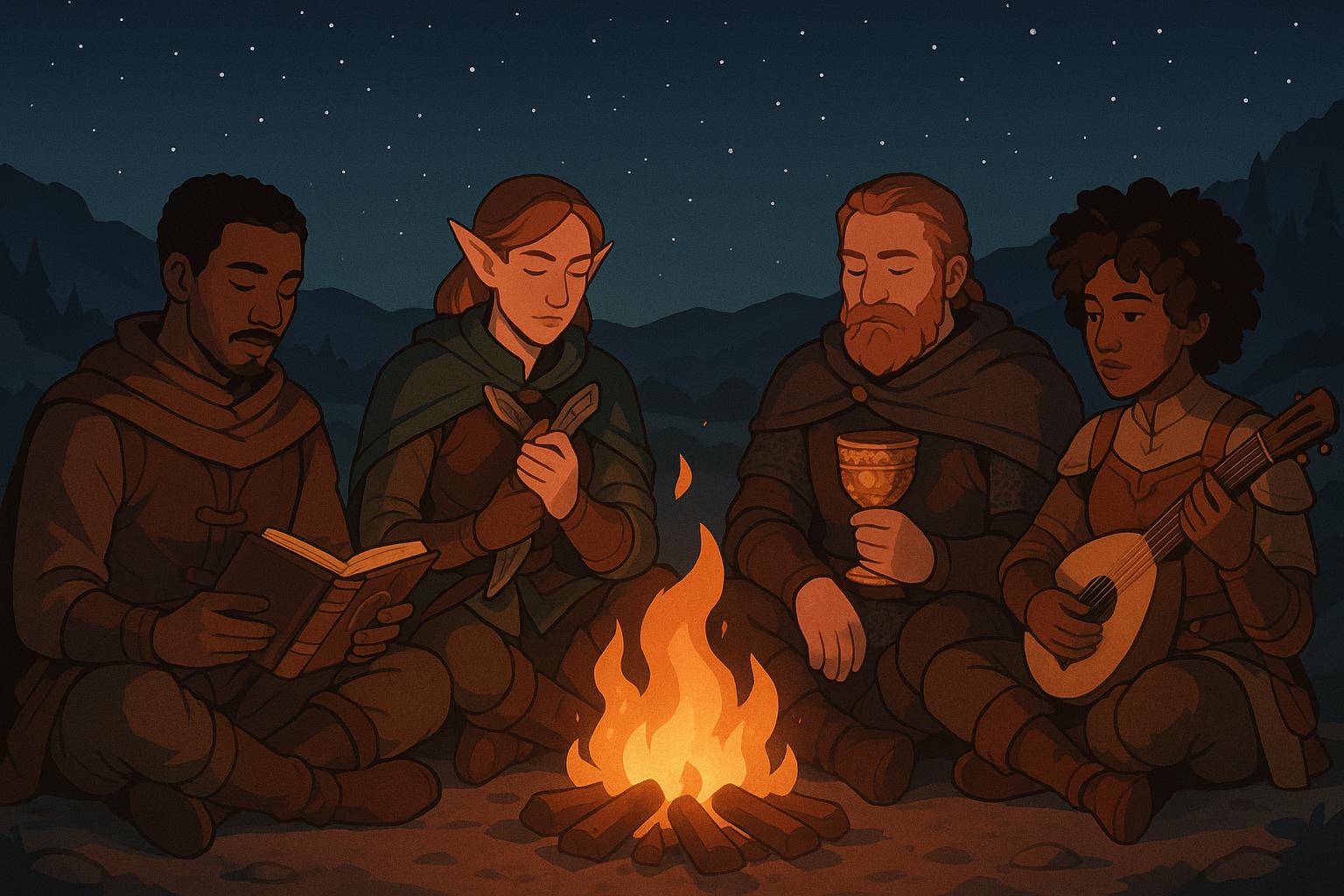Point allocation systems in RPGs let players manage a limited pool of points to perform actions like moving, attacking, or using abilities. These systems add strategy by requiring players to balance their resources each turn. For example:
- Action Points: Points refresh each turn and are spent on actions.
- Cost Balancing: Stronger actions cost more points, encouraging trade-offs.
- Resource Management: Players decide whether to spend or save points for future turns.
Games like Space Hulk and Jagged Alliance use these systems to create tactical depth, while others, like Feng Shui, allow reserving points for defense. While engaging, these systems can slow gameplay or overwhelm new players if not designed carefully. For more examples, check out the TTRPG Games Directory, which lists games with these mechanics and their unique features.
UPGRADE Your TTRPG Combat + 4 Action Points
How Point Allocation Systems Function
Point allocation systems are a key element in RPGs, laying out a structure where every action comes with a cost. They turn combat and character interactions into strategic decisions that directly affect the flow of the game.
Mechanics of Point Allocation Systems
These systems give characters a set number of action points, which refresh at specific intervals. Actions like moving, attacking, or using abilities consume these points, with stronger actions requiring more. Some systems allow unused points to roll over into the next turn, opening up more tactical possibilities. The way points refresh - whether fully or partially - also adds depth to decision-making [1].
Components of Point Allocation Systems
The main elements of these systems work together to keep the gameplay balanced and engaging:
- Action Points and Refresh Mechanics: Each character has a pool of action points to spend per turn, often influenced by attributes or special abilities. These points usually reset at the start of a turn, though some systems allow gradual accumulation or carryover, encouraging players to think ahead.
- Action Costs and Balance: Stronger actions cost more points, forcing players to decide between several smaller moves or saving up for a big play. The system ensures fairness by adjusting costs for powerful actions and rewarding smart decisions, like strategic positioning or defensive choices [2].
Pros and Cons of Point Allocation Systems
Point allocation systems in RPGs come with their own set of strengths and challenges that influence how players engage with the game. Both players and designers can benefit from understanding these aspects to make better choices about using such systems.
Advantages
Point allocation systems bring a layer of strategy to gameplay. Players can distribute points across actions like movement, attacks, or abilities, as seen in games like Space Hulk and Jagged Alliance [1]. This approach allows for a variety of playstyles, making characters feel distinct and impactful during combat.
The resource management element adds another layer of engagement. Players must decide whether to spend points immediately or save them for defensive moves. For example, Feng Shui incorporates a mechanic where players can reserve points for defense, adding a tactical element [1]. This decision-making process keeps players engaged and ensures every session feels dynamic and personalized.
Disadvantages
On the flip side, these systems can introduce complexity that slows the game down, particularly in tabletop settings. Tracking points and modifiers can interrupt the flow of gameplay. Additionally, players might exploit unbalanced mechanics or lean too heavily on defensive tactics, which can reduce the variety of strategies [1].
| Aspect | Advantages | Disadvantages |
|---|---|---|
| Gameplay | Adds strategy and flexibility | Slows pace due to tracking |
| Balance | Supports fairness across classes | Risk of unbalanced mechanics |
| Player Experience | Encourages resource management | Can overwhelm newer players |
| Combat Dynamics | Enables varied action choices | May lead to repetitive strategies |
| Character Development | Promotes diverse playstyles | Requires careful monitoring |
Some games, like Shadowrun, have successfully integrated action point systems with initiative mechanics, creating a smoother and more dynamic experience [1]. While these systems can enhance strategic depth, their design must strike a balance between complexity and playability to avoid frustrating players.
sbb-itb-b8b00a5
Designing Point Allocation Systems in RPGs
Design Considerations
When creating point allocation systems, it's crucial to weigh their strengths and weaknesses to craft mechanics that elevate gameplay. A well-designed system balances costly, impactful moves with cheaper, more frequent actions, encouraging players to think strategically. Players should face meaningful decisions: save points for powerful moves or spend them on smaller actions to stay adaptable.
| Action Type | Description |
|---|---|
| Basic Actions | Low cost (1-2 points), easy to use often, and provide versatility |
| Power Moves | High cost (5+ points), significant impact, capable of shifting the game's flow |
Mechanics like point caps or diminishing returns help prevent players from stockpiling points, keeping the system balanced. The goal is to offer a variety of meaningful choices while avoiding repetitive or overly dominant strategies.
Several games have shown how to successfully implement these systems, finding the right mix of complexity and engagement.
Examples of Effective Systems
Games such as Space Hulk showcase how refreshing action points each round creates engaging tactical decisions. Similarly, Jagged Alliance combines point allocation with other mechanics, providing strategic options without overwhelming players [1].
What makes these systems work? They share a few key traits:
- Clear Mechanics: Players understand the costs and effects of their actions.
- Strategic Variety: There are multiple effective strategies, and no single approach dominates.
- Resource Management: Players must carefully decide how to allocate their points.
- Balanced Costs: Actions are priced fairly based on their impact.
TTRPG Games Directory

If you're curious about how point allocation systems work in practice, the TTRPG Games Directory is a great resource. It offers a wide range of classic and indie tabletop RPGs, complete with detailed descriptions of their mechanics, including point allocation systems.
| System Type | Examples |
|---|---|
| Action Points | Tactical combat games |
| Skill Points | D&D-style games |
| Attribute Points | Traditional RPGs |
The directory categorizes games to help you find ones that suit your preferred style. Each listing dives into the mechanics, balance, and player feedback, focusing on aspects like:
- How easy the system is to learn
- The balance between different actions
- How well the system integrates with other game elements
- Insights from community reviews
By exploring these games, both players and designers can gain a better understanding of how point allocation systems influence gameplay. This can be especially helpful for those looking to design or refine their own game systems.
The directory also puts a spotlight on both well-known and indie games, breaking down how their mechanics impact the overall experience. Whether you're into tactical depth or resource management, this resource can guide you to games that align with your interests.
Conclusion
Point allocation systems bring a strategic edge to gameplay, as seen in titles like Space Hulk and Jagged Alliance. These systems allow for dynamic combat scenarios that encourage tactical decision-making while letting players customize their characters. At the same time, they maintain balance by requiring careful resource management [1].
By blending combat mechanics with character development, point allocation systems introduce meaningful trade-offs and add layers of complexity without overwhelming players. Whether it's managing action points in combat or distributing attributes during character creation, these mechanics push players to think critically about their choices.
For more examples, the TTRPG Games Directory highlights games with various point allocation systems, offering a closer look at how these mechanics work. Whether you're a player or a designer, understanding the balance between player freedom and game structure is key to appreciating the depth these systems bring to RPGs.


